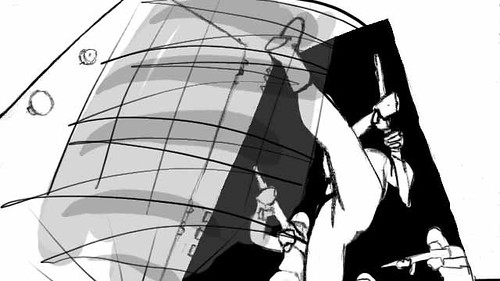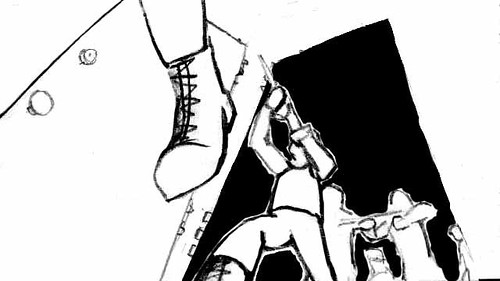I worked on some animation a bit last night. I’ve been having a hard time motivating myself to work on DFtS. I guess I’ve been pretty busy lately, but even when I have free time I seem to be more likely to watch a movie than work on animation.
Part of it is that this scene I’m working on seems to be going rather differently than the stuff I do on Foster’s Home for Imaginary Friends. I think the difference is that that show is storyboarded with the medium in mind. That is, they make it so that it will animate well in the 2D Flash world of Foster’s. I boarded my film assuming I would do it traditionally, though, so it has lots of non-orthogonal poses and movement. In fact, there are one or two scenes that I’m going to have to come pretty close to animating traditionally. There’s this one that’s a low-angle shot of some people running and sort of jumping over the camera and I don’t know any way I could do it with stock models. So that’ll be kind of fun to figure out. (Go to the end of this post to see some pictures with moderate spoilage.)
I discovered something recently by watching this animation. Flash is really good at twitchy movements. You can kind of fake movements if they happen in few enough frames, and they still look really good. Watch that animation and you’ll see what I mean – all the characters move in a very twitch way, extremely pose-to-pose. Again, we run into the problem that I didn’t board DFtS specifically for Flash. My story has many places where slower movements are really the most appropriate. Now, since the scene I’m doing right now is one of those, and it involves a head turn (notoriously difficult in Flash), I’ve had to eschew tweens entirely, doing the whole thing on twos. If I try to do it on ones it’ll just take way too long to make it look smooth, and even then it’ll probably look muddy.
Interesting fact for the day: sometimes animation looks better on twos than it does on ones. Sometimes when I’ve animated something on ones I’ll go in and take out every other keyframe and it ends up looking a lot better. I figure it’s because the human brain can fill in the gaps on viewing better than the animator can on creation. Sometimes it’s better just to trust in Mother Nature and use our built-in tools to make something look good.
Here, look at what I’m talking about (Warning: spoilers! scroll down to see the pictures):

